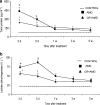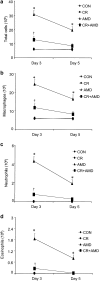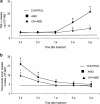Protective effects of curcumin against amiodarone-induced pulmonary fibrosis in rats
- PMID: 12890714
- PMCID: PMC1573957
- DOI: 10.1038/sj.bjp.0705362
Protective effects of curcumin against amiodarone-induced pulmonary fibrosis in rats
Abstract
(1) We have studied whether curcumin prevents amiodarone-induced lung fibrosis in rats. Intratracheal instillation of amiodarone (6.25 mg kg(-1) on days 0 and 2, and then killed on day 3, day 5, week 1, week 3 and week 5 after amiodarone administration) induced increases in total protein and lactate dehydrogenase (LDH) activity on days 3 and 5 in bronchoalveolar lavage fluid (BALF). Total cell counts, alveolar macrophages, neutrophils and eosinophils recovered by BAL, and lung myeloperoxidase (MPO) activity were significantly higher in amiodarone rats. (2) Tumor necrosis factor-alpha (TNF-alpha) release after lipopolysaccharide (LPS) stimulation and superoxide anion generation after phorbol myristate acetate (PMA) stimulation were higher in the alveolar macrophages of amiodarone rats at 3 and 5 weeks postamiodarone instillation than in controls. Amiodarone also induced increases in transforming growth factor-beta1 (TGF-beta1) expression, collagen deposition, type I collagen expression and c-Jun protein in lungs. (3) Curcumin (200 mg kg(-1) body weight after first amiodarone instillation and daily thereafter for 5 weeks)-treated amiodarone rats had reduced levels of protein, LDH activity, total cell numbers and differential cell counts in BALF. LPS-stimulated TNF-alpha release and PMA-stimulated superoxide generation were significantly suppressed by curcumin. Furthermore, curcumin inhibited the increases in lung MPO activity, TGF-beta1 expression, lung hydroxyproline content, expression of type I collagen and c-Jun protein in amiodarone rats. Our results have important implications for the treatment of amiodarone-induced lung fibrosis.
Figures






References
-
- ABE Y., HASHIMOTO S., HORIE T. Curcumin inhibition of inflammatory cytokine production by human peripheral blood monocytes and alveolar macrophages. Pharmacol. Res. 1999;39:41–47. - PubMed
-
- AHSAN H., PARVEEN N., KHAN N.U., HADI S.M. Pro-oxidant, anti-oxidant and cleavage activities on DNA of curcumin and its derivatives demethoxycurcumin and bisdemethoxycurcumin. Chem. Biol. Interact. 1999;121:161–175. - PubMed
-
- AMMON H.P.T., WAHL M.A. Pharmacology of Curcuma longa. Planta. Med. 1991;57:1–7. - PubMed
-
- ANGEL P., KARIN M. The role of Jun, Fos and the AP-1 complex in cell-proliferation and transformation. Biochim. Biophys. Acta. 1991;1072:129–157. - PubMed
-
- ARAUJO C.A.C., LEON L.L. Biological activities of Curcuma longa L. Mem. Inst. Oswaldo Cruz. 2001;96:723–728. - PubMed
Publication types
MeSH terms
Substances
LinkOut - more resources
Full Text Sources
Medical
Research Materials
Miscellaneous

